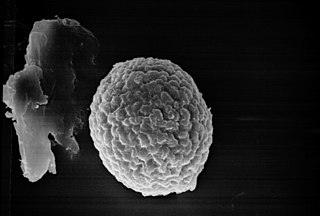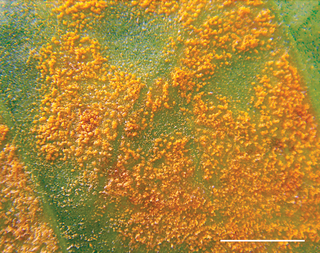
Rusts are fungal plant pathogens of the order Pucciniales causing plant fungal diseases.

Tilletia is a genus of smut fungi in the Tilletiaceae family. Species in this genus are plant pathogens that affect various grasses. Tilletia indica, which causes Karnal bunt of wheat, and Tilletia horrida, responsible for rice kernel smut, are examples of species that affect economically important crops.

Heliocarpus is a genus of flowering plants in the family Malvaceae. It was formerly classified in the Tiliaceae.

Uromyces is a genus of rust fungi in the family Pucciniaceae. The genus was described by Franz Unger in his 1833 work Die Exantheme der Pflanzen. They have a worldwide distribution but large occurrences happen in North America and Europe.

Pucciniastrum is a genus of Basidiomycota fungi. Pucciniastrum species, like all rust fungi, are obligate plant parasites.

Puccinia jaceae var. solstitialis is a species of fungus in the Pucciniaceae family. It is a plant pathogen that causes rust. Native to Eurasia, it is the first fungal pathogen approved in the United States as a biological control agent to curb the growth of the invasive weed yellow starthistle.
The Pucciniosiraceae are a family of rust fungi in the order Pucciniales. The family contains 10 genera and 57 species.
Maravalia is a genus of rust fungi in the Chaconiaceae family. The widespread genus contains about 35 species that grow on angiosperms.
Olivea is a genus of rust fungi in the family Chaconiaceae. The widespread genus contains eight species that grow on dicots, especially the tropical flowering plant family Verbenaceae.

Chrysomyxa is a genus of rust fungi in the family Coleosporiaceae. The genus, widespread in the Northern Hemisphere, contains about 23 species. Rust fungi in the genus Chrysomyxa occur in boreal forests of the northern hemisphere on Pinaceae,, and most species alternate to angiosperm hosts in the Ericaceae.

Edwin Butterworth Mains (1890–1968) was an American mycologist. He was known for his taxonomic research on the rust fungi (Pucciniomycetes), the genus Cordyceps, and the earth tongues (Geoglossaceae).
Paul Dietel was a German mycologist.
Clonostachys is a genus of fungi in the order Hypocreales and family Bionectriaceae.

Hemileia is a genus of rust fungi, now placed in the family Zaghouaniaceae, but long considered incertae sedis in the order Pucciniales. This genus has a pan-tropical distribution and includes important crop plant pathogens, such as the causative organism of coffee leaf rust.
Uredo is a genus of rust fungi: long considered incertae sedis in the order Pucciniales, but now placed in the family Pucciniaceae. This long-established genus, together with the closely-related Uromyces, give their names to "uredo-type" fungal spore structures such as "urediniospore" and uredinium".








